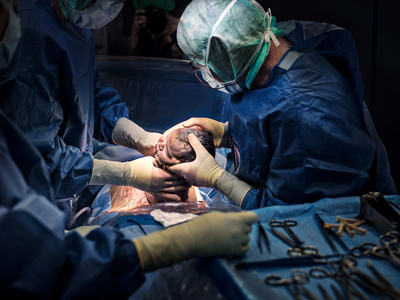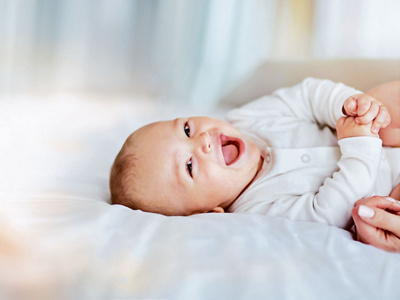A caesarean delivery is usually performed if a natural birth poses too high a risk to the mother or baby and is therefore not possible. Thanks to regional anaesthesia, the mother is still able to witness the birth despite having a C-section. In this case, the baby’s father can also be present.

The caesarean section at a glance
A caesarean birth, referred to as a ‘caesarean section’ in medical terms, is a surgical delivery method where the baby is born through an incision in the wall of the abdomen and uterus. Today, around 30% of children in Switzerland are born by C-section. The decision to have a C-section is usually made during pregnancy.
Treatment goal
A caesarean is aimed at making birth as safe as possible and protecting the health of both the mother and child. A planned C-section (primary caesarean) is determined at an early stage, for example in the case of pre-existing health conditions. If complications occur during delivery, the intervention is usually performed as an unplanned C-section (secondary caesarean) to quickly protect the mother and child.
Reasons for a planned C-section
Some women opt for a caesarean operation for personal reasons. For others, a C-section is necessary due to medical circumstances. Medical indications for a C-section include the following:
- The pelvis is too narrow for vaginal delivery
- The baby is in a breech or oblique position
- The placenta is located in front of the cervix and blocking the birth canal (placenta praevia)
- The placenta has become detached from the wall of the uterus
- Malformations in the baby (e.g. spina bifida)
- Umbilical cord prolapse
- The baby is not getting enough oxygen
- Pre-eclampsia or gestational diabetes in the mother
- Any situation during birth that endangers the life of the child or mother
Procedure
A caesarean section is usually performed under regional anaesthesia using a spinal block (spinal anaesthesia). This allows the mother to be fully conscious to witness the birth of her child. Of course, the father of the child can also be present during the caesarean. He can sit next to his partner’s head and support her during the caesarean birth.
A caesarean birth proceeds quickly and usually takes just 5 to 10 minutes. The abdominal incision is made horizontally, usually around the pubic hair line (bikini line). During the procedure, the abdominal wall and uterus are carefully opened and the child is delivered. The newborn is then wrapped up in warm towels and the mother can see and touch them. Afterwards, the father can care for the child together with the midwife while the mother’s surgical wounds are being closed. The entire intervention takes around 45 minutes.
After the procedure, the mother spends around 2 hours in a monitoring unit. At this point, she already has the newborn with her and is able to breastfeed them for the first time. If everything goes normally, mother and child can leave the hospital after a few days.
Preparation and precautions
A planned caesarean is usually performed around the 38th week of gestation. Under normal circumstances, the patient is admitted to the hospital several hours before the operation is scheduled. The patient must have an empty stomach for the intervention, meaning that she must not have eaten any solid food for around 6 hours beforehand. Another pregnancy check-up is performed before the C-section. Before the operation, the pubic hair is shaved and a bladder catheter inserted.
Aftercare and recovery
Physical rest is especially important in the days following the caesarean. It is important to avoid heavy physical activities and lifting heavy loads for some time after the surgery. The uterus needs more time to return to normal after a C-section than it would after a vaginal delivery. As a result, post-partum bleeding lasts slightly longer. A check-up with a gynaecologist is recommended around 4 to 6 weeks after a C-section.
Scar care
The only visible reminder following a C-section delivery is usually a scar just above the pubic bone, measuring 8 to 12 centimetres. Targeted care is particularly important for supporting healing as best as possible:
- Rest: Following the surgery, the patient needs physical rest and should avoid lifting heavy objects.
- Gentle massage: Once the scar has healed completely, the patient should massage the affected area carefully to promote blood circulation and prevent any adhesions from forming.
- Special scar creams: Scar creams or gels can be used to keep the tissue supple and assist with wound healing.
- Avoid sun exposure: The scar should be protected from direct sunlight to prevent discolouration and avoid any negative impacts on the healing process.
Post-natal recovery
The body needs time to regenerate, regardless of whether the mother gave birth vaginally or via C-section. However, the healing process after a caesarean usually takes somewhat longer. Post-natal recovery includes targeted exercises and measures for strengthening the body and stabilising the tissue in the abdominal and pelvic regions. Since a caesarean delivery involves cutting through the abdominal wall, recovery is especially important for strengthening the muscles and restoring normal pelvic floor function. After consultation, the following measures can help with recovery after a C-section:
- Gentle pelvic floor exercises
- Breathing exercises
- Gentle strengthening exercises for the abdominal muscles
- Taking advantage of professional support (physiotherapy or post-natal recovery courses)
Potential complications
A caesarean is a low-risk routine intervention for both mother and child, and usually proceeds without any complications. As with all surgeries, in rare cases infections, nerve injuries, bleeding or blood clots may occur. Adhesions can sometimes occur in the abdominal cavity.
In addition, there is a slightly increased risk that the child could develop an allergy, asthma or metabolic disease if born via C-section. This is suspected to be related to the lack of contact with the natural bacterial flora found in the birth canal, which can affect the child’s immune system.
Centres 9
-
Maternity unit
-
Maternity Unit
Schänisweg
CH-5001 Aarau



